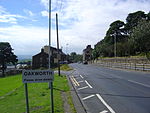Haworth
Former civil parishes in West YorkshireGeography of the City of BradfordHaworthPortal templates with redlinked portalsUse British English from August 2013 ... and 2 more
Vague or ambiguous time from October 2022Villages in West Yorkshire

Haworth (UK: HOW-ərth, also HAW-ərth, US: HAW-wərth) is a village in West Yorkshire, England. Located in the Pennines, Haworth is 3 miles (5 km) south-west of Keighley, 8 miles (13 km) north of Halifax, 10 miles (16 km) west of Bradford and 10 miles (16 km) east of Colne in Lancashire. The surrounding areas include Oakworth and Oxenhope. Nearby villages include Cross Roads, Stanbury and Lumbfoot. Haworth is a tourist destination known for its association with the Brontë sisters and the preserved heritage Keighley and Worth Valley Railway.
Excerpt from the Wikipedia article Haworth (License: CC BY-SA 3.0, Authors, Images).Haworth
Dimples Lane, Bradford Haworth and Stanbury
Geographical coordinates (GPS) Address Nearby Places Show on map
Geographical coordinates (GPS)
| Latitude | Longitude |
|---|---|
| N 53.83 ° | E -1.96 ° |
Address
Dimples Lane
Dimples Lane
BD22 0EJ Bradford, Haworth and Stanbury
England, United Kingdom
Open on Google Maps










